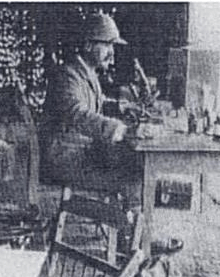Cuthbert Christy facts for kids
Quick facts for kids
Cuthbert Christy
|
|
|---|---|

Christy in Uganda in 1902
|
|
| Born | 1863 |
| Died | 29 May 1932 (aged 68–69) Aka River region, Belgian Congo
|
| Nationality | British |
| Occupation | Medical practitioner, explorer |
| Known for | Christy commission report on slavery in Liberia |
Cuthbert Christy (1863 – 29 May 1932) was an English doctor and animal expert. He explored Central Africa a lot in the early 1900s. He was famous for his work on a disease called sleeping sickness. He also wrote an important report about forced labor in Liberia in the 1920s.
Contents
Early Life and Education
Cuthbert Christy was born in 1863 in Chelmsford, England. He went to school at Olivers Mount in Scarborough, North Yorkshire. Later, he earned a special scholarship to study at the University of Edinburgh. He finished his studies in 1892.
After graduating, he traveled widely. He visited places like South America and the West Indies between 1892 and 1895. From 1898 to 1900, he worked as a senior medical officer in Northern Nigeria. He then worked in Bombay, India, helping with a plague outbreak.
Exploring Africa and Fighting Disease
Christy became very skilled at studying nature and animals. In 1902, the British government chose him for a special team. This team was sent to Uganda to study African trypanosomiasis, also known as sleeping sickness. George Carmichael Low and Aldo Castellani were the other two members.
Sleeping sickness was a big problem in Uganda. Nearly 14,000 people had died by early 1902. The team arrived in Kisumu in July 1902. Christy traveled around, mapping where the disease was found. He took blood samples, noted symptoms, and even trapped mosquitoes.
In 1903, Christy joined another team in the Congo Free State. This team, from the Liverpool School of Tropical Medicine, studied public health. They focused on sleeping sickness. They spent nine months in the Lower Congo. Then they explored areas further upstream.
Christy continued his work in Africa. He was in Ceylon (now Sri Lanka) in 1906. He worked in Uganda and East Africa from 1906 to 1909. Later, he worked in Nigeria, the Gold Coast, and the Cameroons. In 1911, he wrote a book about the African rubber industry.
Between 1911 and 1914, Christy worked for the Belgian government in the Belgian Congo. He mostly studied sleeping sickness there. He explored forests and the Rwenzori Mountains. During World War I (1914–1918), he helped map the border between the Congo and Sudan.
Christy also noticed how travel rules affected people. He saw that more travel permits were given by Congolese officials than by Sudanese ones. He learned that people often used these permits to trade rubber. In 1916, Christy became an advisor for malaria. He worked in military hospitals in Dar es Salaam and Mesopotamia.
From 1920 to 1923, Christy explored the Bahr el Ghazal region in what is now South Sudan. From 1925 to 1928, he led an expedition. This trip, sponsored by the Natural History Museum, explored the Tanganyika lakes. He also worked in French Equatorial Africa and French West Africa from 1928 to 1929.
The Christy Commission in Liberia
In 1929, an American missionary in Liberia reported a serious issue. They said Liberian officials were forcing tribal people to work. These people were then sent to the island of Fernando Po as forced laborers. The Liberian government denied these claims. They invited a special team from the League of Nations to investigate.
Cuthbert Christy was chosen to lead this investigation team. Charles S. Johnson, an American, represented the United States. Arthur Barclay, a former President of Liberia, represented his country. The team started their work on April 8, 1930.
Christy and Johnson traveled into the country's interior. They spoke to many people. They interviewed 264 individuals in total. These included politicians, officials, local leaders, and everyday citizens.
The team's report was submitted in September 1930. It stated that workers were recruited using unfair methods. These methods were very similar to slave trading. The report found that the Liberian government used forced labor. This was for building roads and other public projects. It also found that some forced laborers were used on farms owned by high government officials.
The commission also discovered that Liberian officials had forced young boys to work. These boys were shipped to Fernando Po island. Landowners on the island paid Liberian "recruiters" for these workers. As a result of the Christy report, President Charles D. B. King and Vice-president Allen N. Yancy both resigned.
Some people felt that Christy was too negative about the United States' role in Liberia. They thought he wanted to show that the Firestone Tire and Rubber Company was involved in these unfair practices. Christy and Johnson had different ideas about what the findings meant. Johnson felt Christy's statements were too extreme. They disagreed on whether Liberia could fix these problems while remaining independent. Christy eventually agreed that Liberia should stay independent.
Death and Legacy
In 1930, Charles S. Johnson described Christy as looking and acting much younger than his 66 years. Christy was also known for being a difficult person.
In 1932, Christy was in the Aka River region of the Belgian Congo. He was studying animals for the Belgian government. He was looking for elephants. During his trip, he shot a male buffalo. The wounded animal charged and attacked him. Cuthbert Christy died from his injuries on May 29, 1932.
Animals Named After Him
Some animals are named in honor of Cuthbert Christy. These include Naja christyi, known as the Congo water cobra. Also, Chamaelycus christyi (Christy's banded snake) and Polemon christyi (Christy's snake-eater) carry his name.


